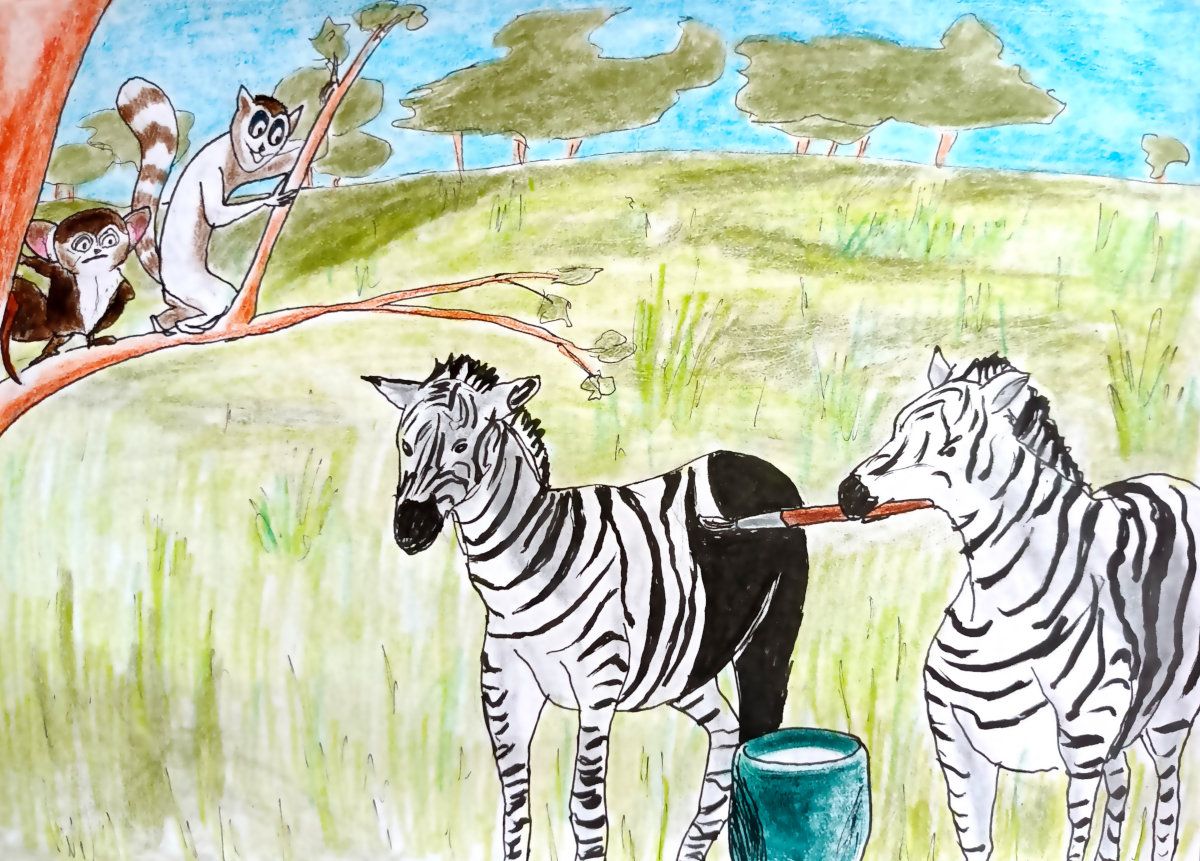White on Black
What colour are zebra stripes, and why do they have them?

What colour are zebra stripes, and why do they have them?
When I was younger, one of my favourite movies was Madagascar, with Alex, a lion, and Marty, a zebra, being my favourite duo. One particular scene from that movie is the reason behind this article you’re reading today—the one where Alex proclaims that Marty is black with white stripes because he has more black stripes than white stripes.
I was one of those self-proclaimed “nature experts” back then, and thought that zebras were white with black stripes. Imagine my surprise, then, when I found out that I did not, in fact, know it all—zebras were actually black with white stripes! It was quite hard to wrap my head around—after all, the stripes looked similar to how a tiger’s stripes look, and tigers are orange with black stripes. But this begs the question: why are they considered to have white stripes? And why do they have stripes in the first place?
The origin of the barcode horse’s markings is a pigment called melanin. Each hair on a zebra’s body grows out of a follicle filled with melanocyte cells that produce the pigment melanin, which adds colour to the skin and fur of most animals. This information, though useful in theory, isn’t exactly helpful on its own. For one, the stripes begin developing in the eighth month of the zebra’s embryonic development, so we can’t exactly look at a newborn zebra and declare whether it’s black with white stripes or vice versa, and for the other, we don’t know whether the melanin is deposited for black stripes or blocked for white stripes.
By default, the melanocytes are supposed to pump out melanin and create black fur. The amount of melanin produced by these melanocytes is decided by paracrine signalling, that is, one melanocyte secretes chemicals which can only be detected by the melanocytes near it. A single signal from a neighbouring cell therefore causes some cells to not produce melanin. To put it in another way, if you were to factory reset a zebra so that all cells followed the default settings, it would be black. Even more compelling evidence is the fact that if you shaved the animal, you’d essentially be left with a black donkey with the temperament of a cat.
Of course, if you don’t want to spend ages speaking about melanin and pigment cells to explain to someone that zebras have white stripes, you could always just show them a picture of Tira the spotted zebra foal.
In a normal animal, the pigment cells produce the appropriate quantity of the enzyme tyrosinase, which is required for the synthesis of melanin. In some rare cases, though, there is either not enough or too much tyrosinase. These lead to conditions such as albinism, where there is no tyrosinase at all, leucism, where there isn’t enough, and pseudo-melanism and melanism, where there is too much. Take, for instance, the feline family—from black leopards and king cheetah to white tigers and albino cats, they have it all.
In felines, two genes, Taqpep and Ed3n, affect the pattern on their bodies. Taqpep majorly controls the pattern of the feline’s markings—think of it as a tattoo stencil. A single mutation in the Taqpep gene can result in a vastly different appearance, as is demonstrated by the striped body of a king cheetah or the weird stripes of one-third of Simlipal Tiger Reserve’s tiger population. Samples of cheetah skin reveal that the ink that is used to fill in the stencil is a direct consequence of Ed3n activity, with the gene being expressed more in regions of dark fur.
In the case of Tira, it may just be that his melanocytes have no idea where they are and produce a normal quantity of melanin through his body. Although it’s pretty to look at, it has a chance at reducing his life expectancy. After all, the zebra evolved to have stripes for a reason.
We know that the markings of leopards and tigers are a way for them to camouflage in their environment, and it is natural to say the same for the zebra. This is true in a way—the uniform direction of the stripes makes it harder for predators to target individual herd members. It can be compared to the bait balls small fish form when threatened by marine predators. Aside from predators, zebras face another threat: flies.
Biting flies can be pretty dangerous for any equid. My own gelding is allergic to fly bites and occasionally breaks out into hives because of them. Other than causing allergic reactions, insects such as horseflies and tsetse flies in the African plains can cause diseases like equine influenza and sleeping sickness, which have the potential to kill them, and the thin hair of the zebra’s coat isn’t enough to defend against them, and they can’t exactly kick or bite at flies—but here’s where stripes come in again.
Striped surfaces are able to disorient flies—when they approach a striped surface for a landing, they aren’t able to decelerate as they do when landing on a non-striped surface and end up bouncing off. Although we don’t know much about how flies see the world, there are a couple of theories as to what happens. One theory suggests that the stripes act like an optical illusion, while another suggests that the fly views the striped surface as “a series of thin black objects.” Whatever the case may be, one thing is for certain—the barcode horses don’t have to fear flies.
Other than fly protection and predator confusion, zebra stripes also are unique enough that the pattern is used to fingerprint individuals—both by researchers and by other zebras. A mother zebra will imprint on her foal with their striping patterns, vocalisations and scents, while head stallions use the more aggressive aesthetic to defend their territory from other zebras and predators.
Although zebras look like horses and donkeys, you never really see people riding zebras or using them as beasts of burden. Zebras are very temperamental and unpredictable, and the same can be said for any zebra hybrid. It takes a lot of work to get one to trust you, and even if you do succeed, you may have to accept that you’ll never be able to ride it—it simply will not allow anyone to get on its back. Zebras are wild animals, and all we can and should do is admire them from afar.
